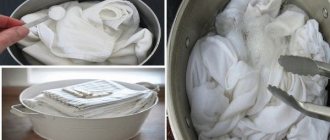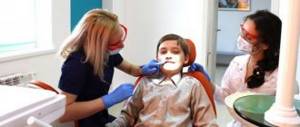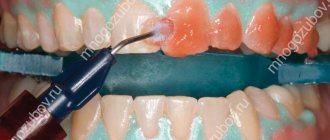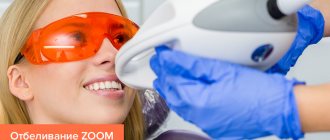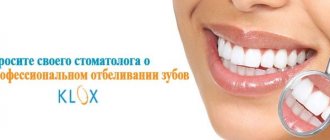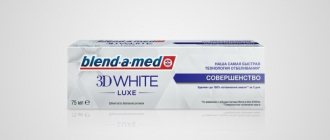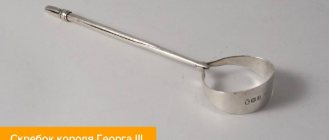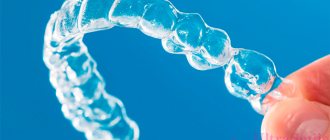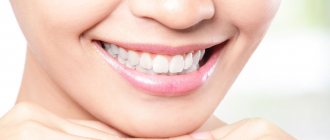- How peroxides whiten dentin
- Hydrogen peroxide
- Urea peroxide
- Where are peroxides found?
- Side effects
Sometimes, to restore whiteness to teeth, you can just remove pigmented plaque from the enamel. If this is not enough, and you are not satisfied with the result, you need to change the natural color of your teeth. This requires dentin bleaching. The fact is that the enamel itself is translucent, and the color of teeth mainly depends on the color of dentin - the hard tissue of the tooth that makes up its main part.
Professional and home whitening products widely use hydrogen and carbamide peroxides. Peroxides are complex substances in which oxygen atoms are connected to each other by single bonds (in other substances by double bonds). Such a connection is easier to break. In addition, in peroxides, oxygen has an oxidation state of “-1” instead of “-2” - that is, it is active during elimination.
Is it possible to whiten teeth with hydrogen peroxide?
With age, every person's tooth enamel becomes thinner and becomes covered with roughness that is invisible to the naked eye.
As a result of smoking, regular consumption of food containing dyes, as well as drinking coffee and tea, a kind of pigmented film is formed on the surface of the teeth, tightly attached to the rough surface of the teeth. It is impossible to remove it with even the most expensive paste, so to restore a beautiful smile, it is necessary to periodically carry out the whitening procedure. In order not to harm the enamel, it is better to entrust such a procedure to specialists. However, if this is not possible, you can resort to gentle remedies at home.
When the need arises to whiten teeth at home, many people use hydrogen peroxide. This product really works as an effective bleach and can eliminate yellow plaque, age spots and darkening.
Dentist on the advantages and disadvantages of teeth whitening with peroxide:
Operating principle
Penetrating into the enamel and dentin of the tooth, the drug reacts with dental tissues, releasing oxygen, which causes organic substances to break down into simpler compounds. Thus, oxygen helps remove plaque.
Sometimes peroxide is used as an antiseptic - for colds, it is used to gargle.
For such rinses, a weakly concentrated solution is used, which does not affect the enamel, but also does not have a whitening effect.
How peroxides whiten dentin
Hydrogen peroxide
Hydrogen peroxide molecules easily penetrate the enamel, releasing active oxygen and oxidizing pigmented dentin. It brightens and, shining through the enamel, makes teeth visually whiter.
Urea peroxide
Carbamide peroxide whitens teeth according to the same principle: when it breaks down, hydrogen peroxide is formed, which gives the desired effect. But the reaction rate of carbamide peroxide is lower. Therefore, the impact on the teeth should be longer. However, the mucous membrane is less irritated. If you have sensitive gums, choose products with carbamide peroxide.
Indications for use
The whitening procedure is indicated in the following cases:
- Yellowing of the enamel due to heavy smoking, drinking large amounts of coffee and tea.
- Regular use of medications containing fluoride. Such preparations include toothpastes and preventive gels with a high content of this microelement. They can only be used periodically, as prophylactic agents.
- Long-term use of tetracycline group medications.
- Yellowing of the enamel color as a result of natural aging of the body.
Preparing your teeth
Since the whitening procedure is quite harmful to tooth enamel, before starting it, measures should be taken to minimize the likelihood of negative consequences.
First of all, visit a dentist who will determine the condition of your teeth and enamel. Any manipulations using peroxide can only be carried out by those people who have thick and fairly durable enamel.
The dentist will examine the teeth, identify areas with darkening and yellowing and determine the nature of their origin. If the yellowness is not outside, but inside the tooth, then peroxide will not give the expected whitening result.
Important to pay attention
In order to whiten your teeth with hydrogen peroxide as safely as possible, you must follow the following recommendations:
- Do not use a solution with a concentration higher than 3%. This is fraught with serious burns of the mucous membranes and irreversible destruction of the enamel.
- If you experience the slightest discomfort, discomfort or burning sensation, you must immediately stop the procedure and rinse your mouth thoroughly with clean water.
- You should refrain from bleaching enamel with peroxide if there are unhealed wounds, cracks or ulcers in your mouth.
- For bleaching, you should use a fresh solution of hydrogen peroxide, since it quickly loses its active properties when exposed to air.
- A prerequisite before the first whitening procedure is to check for possible allergic reactions.
Whitening at home
There are quite a few different ways to lighten teeth with peroxide, and they all have a good effect.
Important! Only 3% peroxide is allowed to be used, since more concentrated solutions will inevitably lead to damage to the enamel.
Peroxide rinse
Rinsing with pure peroxide is one of the simplest methods, so it is recommended for people who are limited in time.
Thus, the rinsing procedure takes no more than 5-10 seconds, which is very convenient if you are in a hurry to work in the morning and do not have the opportunity to spend time preparing the compositions. You should not keep the product in your mouth for more than 10 seconds - this will help minimize the risk of damage to the enamel. During the procedure, tingling and some burning may occur - this is absolutely normal, so there is no need to worry. After rinsing, you need to moisten a cotton swab in the preparation and gently wipe the problem areas.
Then rinse your mouth with warm water and refrain from eating or drinking anything for at least 30 minutes.
For prevention purposes, this method is recommended to be used once a week. If you need to lighten your teeth and remove pigment plaque, rinse your mouth once a day. As a rule, this procedure works quickly and the effect becomes noticeable after 2-3 weeks.
Brushing with a toothbrush
This method also does not take much time and effort.
Whitening is carried out in three stages:
- First, brush your teeth with a toothpaste that contains fluoride.
- Then mix warm water and peroxide in equal proportions in a glass and, dipping the brush into the glass, brush your teeth for 1 minute.
- Rinse your mouth and refrain from eating or drinking anything for the next 30 minutes after the procedure.
Soda mixture
Baking soda is an excellent bleaching agent.
There are recipes for teeth whitening using only soda. When used in combination with peroxide, you will get maximum benefit and visible results. The process itself is performed as follows:
- First of all, prepare a thick paste from peroxide and soda.
- Then apply it to the surface of your teeth. You can use a cotton swab or your fingers to do this.
- Leave the mixture on your teeth for 3 minutes, then rinse your mouth with warm water.
- Afterwards, brush your teeth using fluoride toothpaste.
When using soda and peroxide, it is important to adhere to the following rules :
- Do not use a toothbrush, especially one with hard bristles, to apply the mixture.
- Avoid contact of the mixture with mucous membranes and gums.
- Do not allow the mixture to come into contact with your teeth for more than 3 minutes.
A blogger tries to whiten teeth using a similar recipe:
With water
The whitening process consists of three stages:
- Brushing teeth using fluoride toothpaste. It has a protective effect on the enamel and prevents it from damage.
- Next, you will need to prepare a rinse. For this purpose, mix peroxide with boiled water in equal proportions. Rinse duration is one minute.
- Finally, rinse your mouth with plain water, which will wash away any remaining medication. It is not recommended to consume food or drinks for 30 minutes after the procedure.
With pasta
In a small container, mix peroxide and toothpaste in equal proportions and use the resulting mixture in the morning to brush your teeth.
Soda and salt solution
To properly prepare the solution, you will need :
- 1 part peroxide.
- 2 parts water.
- A pinch of salt.
- A pinch of soda.
Rinse your mouth with the resulting solution for 1 minute.
With tooth powder
Dip the brush in tooth powder and gently apply 2-3 drops of peroxide on top. After this, you need to brush your teeth as usual and rinse your mouth with water.
Soda, hydrogen peroxide, lemon
Prepare a paste of 2-3 drops of lemon juice, peroxide and soda. Apply the mixture to a soft toothbrush and gently brush your teeth.
Video on the topic:
Hydrogen peroxide in the treatment of caries
The cause of dental caries is the bacteria Streptococcus mutans, which forms dental plaque - a biological bacterial film. These microorganisms feed on sugars that enter the human body along with food, and as a result of their processing they form organic acids. The latter destroy enamel, dentin and other tooth tissues.
Thus, plaque poses a threat to the development of caries. At the same time, biological film is difficult to remove or destroy with modern antimicrobial drugs. Several years ago, a team of scientists conducted research and developed nanoparticles that can destroy the structure of dental biofilm, destroy pathogenic microorganisms and prevent the development of caries.
Nanoparticles consist of iron oxide, polysaccharides and some other substances. When exposed to an acidic environment (and bacteria in dental plaque produce a lot of organic acids), these nanoparticles begin to produce hydrogen peroxide. This compound has a powerful antiseptic effect, destroys pathogenic microorganisms, destroys bacterial dental films, thereby protecting teeth from carious lesions. As part of the study, scientists tested their development on volunteers and came to the conclusion that nano-sized particles effectively destroy tartar and destroy bacteria without causing damage to the enamel or disruption of the microflora in the oral cavity. According to the scientists' findings, the use of nanoparticles with a one percent solution of hydrogen peroxide destroys more than 99% of cariogenic bacteria.
Researchers have suggested adding such particles to toothpastes or mouth rinses, since the use of these products can be an excellent preventive measure for dental caries. The practical application of the development can only be discussed after successful clinical trials. But the antiseptic effect of hydrogen peroxide on cariogenic bacteria is beyond doubt.
Peroxide based gels
Today on sale you can find special gels containing hydrogen peroxide and a special substance - urea, which, due to its properties, promotes the active production of oxygen when in contact with air.
Among the most common whitening gels are:
- White Perfect - this product is often used by professional dentists, which confirms that it meets all safety requirements.
- Brilliant is a gentle product, suitable for those with sensitive enamel.
- Teeth Whitening Pen - the product is available in the form of a pencil with a brush, which greatly facilitates the application process.
- White Light is a gel designed for use with mouth guards and a UV lamp. Those who decide to use this particular drug will have to take care of purchasing a lamp and cap.
Possible complications
The use of the drug gives a good lightening result. But its incorrect and frequent use can lead to the development of unpleasant consequences, the most severe of which are the progressive destruction of tooth enamel and changes in the structure of the teeth.
This complication is explained by the ability of the components of the product to penetrate deeply into all layers of enamel and have a destructive effect on them.
Other problems may also appear.
Tooth hypersensitivity
A person experiences discomfort and even sharp pain when consuming cold or hot food or drinks. The cause of hypersensitivity lies in the thinning of the enamel.
This process is reversible. It will be enough to use a special gel or paste that will saturate the enamel tissue with minerals and block the reaction of nerve endings.
Chalked (re-whitened) teeth
Such a complication is rarely diagnosed and only in those who use peroxide in combination with baking soda for whitening for a long time. The initially shiny top layer wears off, revealing the inner layers.
The shine is lost, and the tooth itself looks like a coated surface. You will not be able to get rid of this condition on your own. Dentist assistance will be required.
All about laser teeth whitening and reviews from specialists and clients. See here photos of fluoridation of teeth in children.
Follow the link https://dr-zubov.ru/lechenie/chelyust/pochemu-shhelkaet-pri-otkrytii-rta.html to find out why your jaw may click.
Demineralization
The appearance of small whitish spots on the surface of the enamel, which gradually become more pronounced. Their formation indicates the loss of minerals necessary for teeth.
If appropriate measures are not taken in a timely manner, demineralization will lead to their destruction.
Today dentistry has a technique that allows you to stop the destruction process and enrich the enamel with lost minerals.
Irritation of the mucous membrane, burning, and changes in taste perception may also occur. But these complications are short-term and disappear after repeated thorough rinsing of the mouth.
Considering the consequences of such whitening, it is necessary to use this product with caution, after consulting a dentist.
Precautionary measures
- Before using peroxide, you need to do a sensitivity test by applying the product to the inside of the elbow.
- Peroxide is a very strong oxidizing agent. It can not only lighten teeth, but also increase their sensitivity. Therefore, people who experience discomfort or painful sensations on their teeth while eating hot or very cold food should avoid using this product.
- Also, people with periodontal disease, caries and teething wisdom teeth should not use this product.
- Peroxide should not be used by children under 12 years of age, since their tooth enamel is still developing and is not very dense. Pregnant women and people who wear braces or crowns should avoid using peroxide as a teeth whitener.
Reference! You can use peroxide for teeth whitening no more often than 1 course, consisting of 2-3 weeks, every 2-3 months.
When to use the solution is contraindicated
Not everyone can use the dental solution. This is why you should first visit your dentist and get his consent. In the following conditions, such measures are contraindicated:
- the presence of untreated carious cavities in the mouth,
- acute forms of gingivitis and periodontitis,
- the presence of old fillings and crowns that require replacement,
- stomatitis, pharyngitis - whitening can be started only after complete recovery.
The solution may contribute to the further spread of caries if there are unhealed holes in the mouth at the time of the procedure. In any inflammatory process, the substance will corrode the affected areas, which will only worsen the situation. Before starting the course, you must replace all old fillings. Otherwise, when the filling becomes depressurized, the solution can easily penetrate into the space between it and the tooth, and this will cause inflammation.
The procedure is not recommended for periodontitis
The composition should not be used during orthodontic correction if the mouth has braces. Individual structural elements may slightly injure the enamel, but when these areas come into contact with peroxide, the pathological process will only intensify. The product should not be used during pregnancy and breastfeeding, in childhood, with thinning enamel and hyperesthesia.
Effect of use
The effect of lightening the color of teeth by 1-2 shades will occur already 2-3 weeks after the start of the procedures. To prevent repeated darkening of the enamel, it is advisable to repeat the procedure at least 2-3 times a year.
Possible negative consequences
When using peroxide, you need to be careful not to harm your dental health. Thus, an incorrectly performed procedure can cause bleeding gums as a result of a chemical burn.
If you have a filling, you should take into account that if it does not fit tightly, peroxide can penetrate inside the tooth, which will lead to accelerated destruction.
Experiment using peroxide for whitening:
Contraindications
It is imperative to take into account that there are certain contraindications to the use of hydrogen peroxide:
- pregnancy;
- breastfeeding period;
- development of periodontal disease;
- gum disease;
- increased sensitivity of enamel;
- extensive carious process;
- the presence of a large number of fillings;
- installed braces;
- allergy to peroxide;
- childhood and adolescence.
If any of the above factors are present, it is necessary to select other teeth whitening methods.
Advantages and disadvantages
The method has both advantages and some disadvantages. Benefits include :
- Availability.
- Efficiency.
Among the disadvantages are:
- The presence of a large number of contraindications.
- High probability of enamel injury.
Contraindications
The use of this drug is contraindicated in the following cases :
- Diseases of the oral cavity occurring in the acute stage.
- Caries, periodontal disease.
- Presence of braces or other orthodontic systems.
- Weak enamel.
- Age up to 12 years.
In the absence of the listed contraindications, it is still advisable to consult a dentist and carry out the procedure only with his consent.
Reviews from doctors and patients
- Lyudmila B: Recently I had an urgent need to whiten my teeth. I didn’t have time to go to the dentist, so I decided to try a recipe with peroxide, salt and soda. I didn’t expect that simple home remedies could completely clean and improve the appearance of teeth in just one go. However, I want to warn you: I decided to take a 7-day course, and already on the fifth day my teeth became very sensitive to cold and hot foods.
- Dmitry K: A friend recommended the method of teeth whitening using peroxide. The fact is that I am a heavy smoker, and, accordingly, the color of my teeth leaves much to be desired. The result pleased me: a week after brushing with toothpaste enriched with peroxide, my teeth became noticeably lighter.
- Irina, dentist: For some people, yellowish or grayish teeth are their natural color. And when trying to whiten such teeth, you can cause irreparable harm to their health. In addition, there are a number of contraindications for the use of peroxide, neglect of which also leads to disastrous results. Therefore, I recommend that my patients carry out the whitening procedure only in dental clinics, where special gentle products and professional equipment are used.
Rinsing your mouth with peroxide
One of the effective methods for whitening enamel at home is rinsing your mouth with hydrogen peroxide. To do this, you need to prepare a solution: peroxide and simple chilled water are mixed in a one-to-one ratio. You should rinse your mouth with the prepared preparation for a minute after each brushing of your teeth with toothpaste.
Each time it is necessary to prepare a new peroxide solution. When rinsing, it should not be in contact with the mucous membrane for a long time; after the procedure, you should rinse the mouth with water. To increase the effectiveness of hydrogen peroxide, the crowns should be treated with a remineralizing gel after each rinse.
You need to whiten your teeth with diluted hydrogen peroxide every day for a week. Afterwards, you need to take a break for 10–14 days, after which you can resume the whitening course.
Teeth rinse recipe
To avoid rinsing your mouth with a strong-smelling peroxide solution, you can prepare a flavored mouthwash.
Recipe for preparing a flavored mouthwash based on hydrogen peroxide for teeth whitening at home:
- Take an empty dark glass bottle. Plastic containers cannot be used, as they interact with essential oils.
- Pour 200 ml of distilled or filtered water into the bottle.
- Add 120 ml of hydrogen peroxide (3%) to the water.
- Mix 15 drops of essential oil with 1 tbsp. l. honey
- Place all ingredients in a bottle and mix them thoroughly.
You can rinse your mouth with a peroxide-based solution in courses of two weeks, after each course you must take a break. The following essential oils are suitable for making scented bleach:
- carnations;
- peppermint;
- grapefruit;
- rosemary;
- sweet orange.
